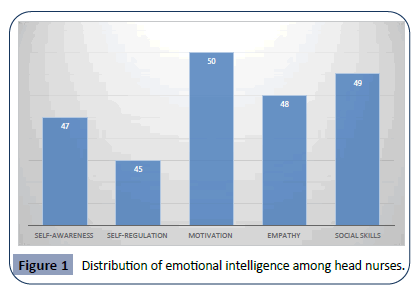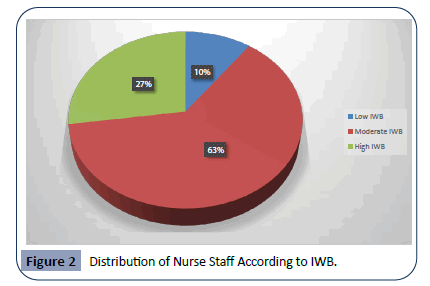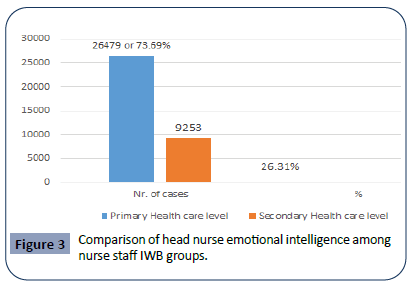Keywords
Emotional intelligence; Innovative work behavior; Leadership; Nurse
Abbreviations
EI: Emotional Intelligence; EIQ: Emotional Intelligence Quotient; EL: emotional leadership; EQ: Emotional Quotient; IWB: Innovative Work Behavior; SD: Standard Deviation
Introduction
Emotional intelligence (EI), emotional quotient (EQ), emotional leadership (EL)and emotional intelligence quotient (EIQ), is defined as the capability of individuals to recognize their own emotions and the others emotions, distinguish between different feelings and label them, use emotional information to lead thinking and behavior, and manage or adjust emotions to adapt to environments or achieve one's goals [1].
Several studies that have shown that people with high emotional intelligence have greater job performance , mental health and leadership skills although no relationships have been shown and this findings are likely to attribute to general intelligence and specific personality traits rather than emotional intelligence as a construct [2].
Another research finds that the effect of emotional intelligence markers on managerial performance and leadership is insignificant when ability and personality are controlled for, and that general intelligence correlates closely to leadership. Markers of emotional intelligence and methods of developing it become more extensively coveted in the previous decade by individuals looking for becoming more active leaders. In addition, other studies have begun to provide evidence to characterize the neural mechanisms of emotional intelligence [3].
Innovative work behavior was defined conferring to the configuration of an activity set consisting of idea generation, knowledge acquisition, and solution implementation. Each stage of the innovative work behavior construct was measured and analyzed separately [3].
In view of the importance of employees’ IWB, researchers studied the factors which were helpful to IWB. Leadership was found to be an important factor that promoted employees’ IWB [4].
The leadership at workplace was characterized as a main agent of change in the organization which is well recognized in the literature. However, in the other study focused on a specific form of relational leadership, namely inclusive leadership. This viewpoint of leadership was more appropriate for investigating advanced environments as it provided the lens for simultaneous investigation of both leadership and employee behavior together determining IWB [5].
In previous studies, innovative behavior was defined as “a multistage process in which an individual recognizes a problem for which she/he generates new ideas and solutions, works to promote and build support for them, and produces an appropriate prototype or model for the use and benefit of the organization or parts within it” [6].
In literature definitions of innovative behavior were defined in several ways overlap with other concepts such as creativity in the workplace, innovative work behavior, entrepreneurship, innovation, organizational citizenship behavior, personal initiative, taking charge, and employee-driven innovation [5-7].
So, the aim of the present study was to assess relation between emotional intelligence of head nurse and IWB in nurse staff.
Patients and Methods
After approval from the institutional ethics committee, informed consent was obtained from each of 50 head nurses and 220 nursing staff.
This analytic cross-sectional study was conducted in University Hospital. A convenient sample of head nurses and their nursing staff who are working in the above mention study setting, at the time of study, and agree to participate after clarification of purpose of the study were included in the current study.
Data collection
Two tools were used to collect the data of this study. Standardized emotional intelligence questionnaire: Adopted by it includes 25-items closed-ended questionnaire. It was used to assess the level of emotional intelligence for head nurses in five dimensions, which are self awareness (3 items), motivation (4 items), self-regulation (5 items), empathy (5 items), and social skills (8 items) [8].
Scoring system: Using a five point Likert-scale ranging from (1- 5) strongly disagree (1), disagree (2), neutral (3), agree (4) and strongly agree (5). The total score is ranging from (25-125), with a score ranging from 101 to 125 indicating high, from 50 to 100 indicating moderate, and below 50 indicating low emotional intelligence.
Modified innovative work behavior questionnaire
It was developed by De Jong [9] to assess innovative work behavior. It consisted of 47 leader behaviors subdivided into 10 dimensions as follows: Innovative role modeling (4 items), stimulating knowledge diffusion (7 items), providing vision (5 items), consulting (5 items), support for innovation (12 items), task assignment and delegation (3 items), organizing feedback (2 items), providing resources (3 items), rewarding (3 items) and monitoring (3 items). The nurses' responses were measured on a five-point Likert scale ranged from (5) Strongly agree to (1) Strongly disagree. The scoring levels were arranged as follows; <65% for low innovative work behavior, from 65 - <75% for moderate innovative work behavior, and ≥ 75% for high innovative work behavior. The internal consistency of this tool was measured by Cronbach's alpha coefficient and it was 0.95.
A pilot study was conducted on twelve nurses to assess the feasibility and applicability of the instruments and to estimate the time needed for each participant to complete the questionnaire sheets. Required changes were made and respondents in the pilot study were excluded from the main study sample. The English formats of the tools were translated into Arabic. After translation, face and content validity were established by a group of seven expertise from faculties of nursing at University, who revised the tools for clarity, relevancy, applicability, comprehensiveness, understanding, and ease for implementation and according to their opinions minor modifications were performed. The opinions of the experts for each item were recorded on a two point scale: agree, disagree.
Data analysis
Data was analyzed by using SPSS 24.0. Quantitative data was presented as mean ± standard deviation while qualitative data was presented as frequency and percentages. ANOVA test was used to compare quantitative variables among groups. Chi square test was used to compare qualitative variables among groups. Pearson correlation analysis was used for assessment of the inter-relationships among quantitative variables. Significant results were defined when the p-value was less than 0.05.
Results
Table 1 show that 54% of nurses' age was > 30 years, with a mean age of 31.34 ± 9.23. As well, the highest percentages of nurses were female, worked for more than 10 years of experience, and had a nursing school diploma (60%, and 56%, respectively). Table 2 and Figure 1 present the means of each component of emotional intelligence of head nurse with a total mean of (79.6 ± 6.4).
Table 1 Personal Data of Head Nurses (N=50).
| Baseline characteristics |
No |
% |
| Age (years) |
|
| Mean ± SD |
(31.34 ± 9.23) |
| ≤ 30 |
23 |
46 |
| >30 |
27 |
54 |
| Gender |
|
|
| Male |
4 |
8 |
| Female |
46 |
92 |
| Experience years |
| ≤ 10 |
20 |
40 |
| >10 |
30 |
60 |
| Nursing qualification |
| Nursing diploma |
28 |
56 |
| Technical institute |
15 |
30 |
| Faculty graduate |
7 |
14 |
Table 2 Emotional intelligence among head nurses (n=50).
| Emotional intelligence |
No |
% |
Range |
Mean ± SD |
| Self-Awareness |
47 |
94 |
54-96 |
76.4 ± 8.7 |
| Self-Regulation |
45 |
90 |
53-94 |
77.5 ± 7.9 |
| Motivation |
50 |
100 |
55-98 |
81.4 ± 9.1 |
| Empathy |
48 |
96 |
52-98 |
79.3 ± 10.2 |
| Social Skills |
49 |
98 |
54-96 |
80 ± 9.5 |
| Total |
50 |
100 |
56-92 |
79.6 ± 6.4 |

Figure 1: Distribution of emotional intelligence among head nurses.
Figure 2 shows that most of nurse staff has moderate IWB (63%), 27% has high IWB and 10% has low IWB.

Figure 2: Distribution of Nurse Staff According to IWB.
Table 3 shows that there are statistically significant differences between nurse staff groups as regards IWB components (p<0.05).
Table 3 Innovative work behavior among nurse staff (n=220). 1. ANOVA test used; 2. Chi square test used. *Statistically significant as p<0.05.
| IWB |
Low IWB (N=22) |
Moderate IWB (N=138) |
High IWB (N=60) |
P-value |
| Innovative role modeling |
5.2 ± 2.3 |
8.6 ± 1.2 |
11.5 ± 1.6 |
0.002*1 |
| Support for innovation |
11.6 ± 3.1 |
16.3 ± 3.5 |
21.4 ± 1.3 |
0.018*1 |
| Stimulating knowledge diffusion |
6.5 ± 1.9 |
10.3 ± 2.6 |
13.6 ± 2.1 |
0.023*1 |
| Providing vision |
4.6 ± 1.5 |
5.6 ± 3.3 |
7.8 ± 1.9 |
0.001*1 |
| Consulting |
5.1 ± 1.8 |
7.3 ± 1.4 |
11.2 ± 2.1 |
<0.001*1 |
| Task assignment and delegation |
5.3 ± 2 |
8.1 ± 1 |
10.7 ± 2.3 |
0.030*1 |
| Organizing feedback |
3.1 ± 1.6 |
5.8 ± 1.5 |
9.9 ± 2 |
0.009*1 |
| Rewarding |
3.2 ± 2.1 |
6 ± 1.4 |
7.9 ± 1.5 |
0.006*1 |
| Providing resources |
1.2 ± 1.4 |
3.9 ± 1.7 |
5.4 ± 1.6 |
0.004*1 |
| Monitoring |
3.3 ± 1.7 |
4.2 ± 1.3 |
8.1 ± 2.2 |
<0.001*1 |
| Total score |
55% |
71% |
77% |
<0.001*2 |
Table 4 and Figure 3 shows that there are statistically significant differences between nurse staff groups according to IWB as regards emotional intelligence components among head nurses (p<0.05).
Table 4 Comparison of head nurse emotional intelligence among nurse staff IWB groups. 1. ANOVA test used. *Statistical significant when p-value <0.05.

Figure 3: Comparison of head nurse emotional intelligence among nurse staff IWB groups.
| IWB |
Low IWB |
Moderate IWB |
High IWB |
P-value |
| (N=22) |
(N=138) |
(N=60) |
| Self-Awareness |
52.6 ± 2.4 |
77.6 ± 9.1 |
81.2 ± 1.9 |
0.016*1 |
| Self-Regulation |
55.6 ± 2.7 |
74.5±6.7 |
84.3 ± 4.5 |
0.005*1 |
| Motivation |
58.2 ± 1.3 |
75.9 ± 9.4 |
88.9 ± 7.3 |
0.003*1 |
| Empathy |
52.3 ± 2.1 |
79 ± 8.3 |
83.6 ± 10 |
0.022*1 |
| Social Skills |
56.4 ± 2 |
78.4 ± 7.3 |
90.3 ± 8.9 |
<0.001*1 |
| Total score |
55.2 ± 3.5 |
75.2 ± 9.3 |
89.4 ± 7.8 |
0.001*1 |
Table 5 shows that there is statistically significant direct correlation between nurse staff IWB and emotional intelligence of head nurses.
Table 5 Correlation between head nurse emotional intelligence and staff nurse IWB. 1. Spearman rank correlation used. *Statistical significant when p-value <0.05.
| Variable |
IWB |
| |
Rho |
P |
| Emotional Intelligence |
0.421 |
<0.001*1 |
Discussion
Leadership behaviors have the potential to improve organizational competence, nurses' job consummation, and the sense of declaration about problem-solving. The critical role of a leader can improve the capacity of organization members to innovate. Also, control of positive organization climate characteristic provides the organization with the necessary elements to fix problems with inspiration [10].
Therefore, this study aimed to explore the relationship between leadership emotional intelligence and innovative work behavior among nurses at University Hospitals.
As regard the relationship between innovative work behavior and leadership emotional intelligence among nurses; this research results showed that most of our studied nurses with high IWB were among head nurse with higher emotional intelligence. This finding may attribute to the studied nurses preferred to work with a leader using this type of leadership behavior which includes pure vision, engagement to their staff nurses, ability to motivate their team, cooperate and lead others to higher attainment. They could encourage innovation and highlight the significance of appreciating and evaluating staff nurses. These will determine good quality outcomes, healthy working environments for nurses, and safe patient-centered care to new levels of service and it`s sustainability.
The current study finding is in agreement with those of several previous studies as the one performed by El-Demerdash and Aldeeb [11] which assessed the transformational leadership, teamwork and its relation to staff nurses' work commitment, in Egypt; the other one done by Olu-Abiodun and Abiodun [12] who studied the perception of transformational leadership behavior among nurses, in Nigeria, and another one conducted by Majeed et al. [13] who explored the relationship between transformational leadership and organizational individual behavior, in Malaysia, and they found that nurses had a positive perception about transformational leadership behavior.
Regarding relationship between leadership emotional intelligence and innovative work behavior among nurses; the results from this research showed that there was significant direct correlation between leadership emotional intelligence and innovative work behavior among nurses. The possible explanation for this result could be because of that the studied nurses want a more suitable work environment that makes them a feeling of value when they do valuable and experienced work. The current study finding is in agreement with that of other previous studies as the one performed by Mohamed and Gaballah [14] which examined the relationship between organizational leadership and nurses' performance, in Egypt, and found that more than half of nurses experienced a high level of organizational environment.
Similarly, in the research conducted by Aiken et al. [15] who were studying the working conditions of nurses in twelve European countries and found that the majority of nurses had positive perceptions toward work leadership with emotional intelligence. As for the level of innovative work behavior; this study findings showed that only 63% of them have a high average level of innovative work behavior.
Innovation behavior is fairly a new and unaccustomed concept. This in agreement with a study conducted, in Egypt, by Kamel and Aref [16] who examined the perception of staff nurses about organizational culture and its relationship to innovative work behavior at critical care units and found that most of staff nurses have highly innovative work behavior.
This finding is consistent with that of Stoffers et al. [17] who conducted a study about organizational culture and innovative work behavior: A case study by the packaging company. They reported that the employees appreciated innovative work behavior higher in the favored status than in the current status.
Conclusion
The findings of our study showed that emotional intelligence leadership had significant and positive correlation with nurse staff innovative work behavior.
Acknowledgments
Nurses who contributed to the work for their contributions.
Funding
This study was funded by authors only.
Competing and conflicting interests
We don’t declare a conflict of interest and.
28352
References
- Joseph DL, Newman DA (2010) Emotional intelligence: An integrative meta-analysis and cascading model. Journal of Applied Psychology 95: 54-78.
- Groves KS, McEnrue MP (2008) Developing and measuring the emotional intelligence of leaders. Journal of Management Development 27: 225-250.
- Newman DA, Joseph DL, MacCann C (2010) Emotional Intelligence and Job Performance: The Importance of Emotion Regulation and Emotional Labor Context. Industrial and Organizational Psychology: Perspectives on Science and Practice 3: 159-164.
- Fiori M, Antonakis J (2011) The ability model of emotional intelligence: Searching for valid measures. Personality and Individual Differences 50: 329-334.
- Sattayaraksa T, Boon-itt S (2012) Leadership as a determinant of product innovation: a systematic review of the literature. Proceedings of 2012 IEEE International Conference on Industrial Engineering and Engineering Management, Hong Kong.
- Khan ZA, Nawaz D, Khan I (2015) The impact of leadership styles on innovation in health services. Gomal University Journal of Research 31: 143-154.
- Gomes C, Curral LA, Caetano A (2015) The mediating effect of work engagement on the relationship between self-leadership and individual innovation. International Journal of Innovation Management 19: 1-18.
- Kiyani AA, Haroon M, Liaqat AS, Khattak MA, Junaid S, et al. (2011) Emotional intelligence and employee participation in decision-making, African Journal of Business Management 5: 4775-4781.
- De Jong J, Den Hartog D (2010) Measuring innovative work behaviour. Creativity and Innovation Management 19: 23-36.
- Leong CT, Rasli A (2014) The Relationship between innovative work behavior on work role performance: An empirical study. Procedia-Social and Behavioral Sciences 129: 592-600.
- El-Demerdash SM, Aldeeb GA (2016) Head nurses' transformational leadership, collaboration and its relation to staff nurses' work engagement. International Journal of Nursing Didactics 6: 30-39.
- Olu-Abiodun O, Abiodun O (2017) Perception of transformational leadership behaviour among general hospital nurses in Ogun State, Nigeria. International Journal of Africa Nursing Sciences 6: 22-27.
- Majeed N, Ramaya T, Mustamil N, Nazri M, Jamshed S (2017) Transformational leadership and organizational citizenship behavior: Modeling emotional intelligence as mediator. Journal of Management and Marketing: Challenges for the Knowledge Society Journal 12: 571-590.
- Mohamed HA, Gaballah S (2018) Study of the relationship between organizational climate and nurses' performance: A University Hospital Case. American Journal of Nursing Research 6: 191-197.
- Aiken LH, Sloane DM, Bruyneel L, Van Den Heede K, Sermeus W, et al. (2013) Nurses’ reports of working conditions and hospital quality of care in 12 countries in Europe. Int J Nurs Stud 50: 143-153.
- Kamel FF, Aref MAE (2017) Staff nurses perception toward organizational culture and its relation to innovative work behavior at critical care units. American Journal of Nursing Science 6: 251-260.
- Stoffers J, Neessen P, Dorp PV (2015) Organizational culture and innovative work behavior: A case study of a manufacturer of packaging machines. American Journal of Industrial and Business Management 5: 198-207.








